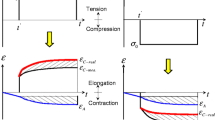Abstract
Autogenous shrinkage, which is a consequence of the absolute volume contraction resulting from cement hydration, occurs in any concrete but its effect is particularly amplified in high performance concrete in which it can be as large as drying shrinkage. Autogenous shrinkage can be directly measured in concrete samples under isothermal conditions but from a practical standpoint the experimental procedure is not always possible. On the other hand, it can be evaluated after having taken into account volumetric variations due to the release in heat during cement hydration. To separate the thermal effect from autogenous shrinkage, it is necessary to know at any moment the evolution of the coefficient of thermal expansion of the concrete from initial setting.
A simple method to determine the coefficient of thermal expansion at early ages is proposed in this paper. It consists in submitting concrete samples instrumented with vibrating wire extensometers to thermal shocks. The response of the concrete sample to this shock results in a nearly instantaneous deformation, which is measured by the sensor. These deformations, as well as the temperature signal, are used to calculate the coefficient of thermal expansion. By repeating this experiment at various ages, it is possible to follow the variation in the coefficient of thermal expansion of the concrete over time.
Résumé
Le retrait endogène qui est une conséquence de la contraction volumétrique résultant de l'hydratation du ciment, se produit dans n'importe quel béton, mais son effet est amplifié dans le cas du béton à haute performance pour lequel son amplitude est comparable à celle du retrait de séchage. Le retrait endogène peut être directement mesuré dans des échantillons de béton en conditions isothermes, mais d'un point de vue expérimental cela n'est pas toujours possible. Il peut aussi être calculé après avoir pris en compte les variations volumétriques dues au dégagement de chaleur lors de l'hydration du ciment. Pour séparer l'effet thermique du retrait endogène, il est nécessaire de connaître à tout instant l'évolution du coefficient de dilatation thermique du béton à partir du début de prise.
Une méthode simple pour la détermination du coefficient de dilatation thermique au jeune âge est proposée ici. Elle consiste à soumettre des échantillons munis de cordes vibrantes, à des chocs thermiques. La réponse du béton à ce choc se traduit par une déformation quasi-instantanée qui est mesurée par l'extensomètre. Ces déformations ainsi que le signal de température sont utilisées pour calculer le coefficient de dilatation thermique. En répétant cette expérience à différents âges, il est possible de suivre la variation du coefficient de dilatation du béton au cours du temps.
Similar content being viewed by others
References
Aïtcin, P.-C., ‘High-Performance Concrete’, E & FN SPON, London, 1998, 591 p.
Aïtcin, P.-C., ‘Does concrete shrink or does it swell’,Concrete International 21 (12) (Dec. 1999) 77–80.
Tazawa, E. and Miyazawa, S., ‘Influence of Autogeneous Shrinkage on Cracking in High-Strength Concrete’, 4th International Symposium on the Utilisation of High Strength and High Performance Concrete, Paris, France, 1996, 321–330.
Japanese Concrete Institute Technical Committee Report on Autogenous Shrinkage of Concrete, Autoshrink '98, Hiroshima, Japan, June 1998, 5–64.
Davis, R. E., ‘Autogenous volume change of concrete’, Proceedings of the 43rd Annual ASTM Meeting, Atlantic City, NJ, June 1940, 1103–1113.
Aïtcin, P.-C., Neville, A. M. and Acker, P., ‘Integrated view of shrinkage deformation’,Concrete International 19 (9) (Sept. 1997) 35–41.
Aïtcin, P.-C., ‘Demystifying autogenous shrinkage’,Concrete International 21 (11) (Nov. 1999) 54–56.
Mehta, P. K. and Monteiro, P. J. M., ‘Concrete: Structure, Properties and Materials’, Prentice Hall Inc., Englewood Cliffs, NJ, 1993, 548 p.
Emanuel, J. H. and Hulsey, L., ‘Prediction of the thermal coefficient of expansion of concrete’,ACI Journal (April 1977) 149–155.
Davis, R. E., “A summary of the results of investigations having to do with volumetric changes in cements, mortars and concretes due to causes other than stress’,ACI Journal 26 (4) (1930) 407–443.
ACI Committee 517, ‘Accelerated curing of concrete at atmospheric pressure’, State-of-the-Art Report, ACI 517.2R-80, ACI Manual of Concrete Practice, Part 5, Detroit, MI, 214–219.
Khan, A., Cook, W. D. and Mitchell, D., ‘Thermal properties and transient thermal analysis of structural members during hydration’,ACI Materials Journal 95 (3) (May–June 1998) 293–303.
Laplante, P. and Boulay, C., ‘Évolution du coefficient de dilatation thermique du béton en fonction de sa maturité aux tout premiers âges’,Mater. Struct. 27 (1994) 596–605.
Boulay, C. and Paties, C., ‘Mesure des déformations du béton au jeune âge’,Mater. Struct. 26 (1993) 308–314.
Petrov, N., Morin, R., Bonneau, O. and Aïtcin, P.-C., “In-situ shrinkage in High-Performance Concrete structures’, Shrinkage 2000: International RILEM Workshop on Shrinkage of Concrete, Paris, October 2000. 16 p.
Alexandersson, J., ‘Strength losses in heat cured concrete Swedish’, Swedish Cement and Concrete Research Institute, Handl., No. 43, 1972, 135 p.
Author information
Authors and Affiliations
Additional information
Editorial Note. Dr. Pierre-Claude Aïtcin is a RILEM Staff Member. Ms Hassina Kada and Mr. Nikola Petrov are RILEM Student Members.
Rights and permissions
About this article
Cite this article
Kada, H., Lachemi, M., Petrov, N. et al. Determination of the coefficient of thermal expansion of high performance concrete from initial setting. Mat. Struct. 35, 35–41 (2002). https://doi.org/10.1007/BF02482088
Received:
Accepted:
Issue Date:
DOI: https://doi.org/10.1007/BF02482088




